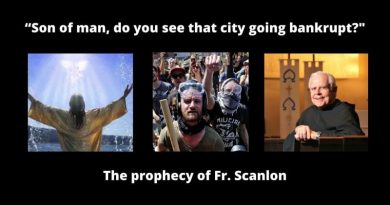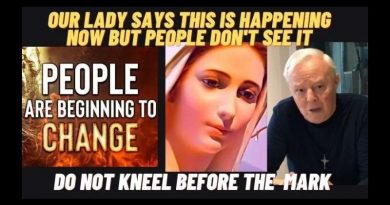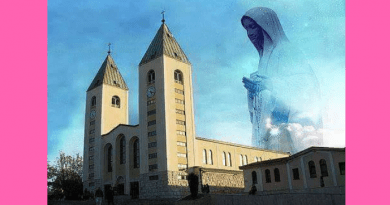The Three Secrets of Fatima
First secret
In her third memoir, written in 1941, Lúcia said that the first secret, a vision of Hell, was disclosed to the children on July 13, 1917.
Our Lady showed us a great sea of fire which seemed to be under the earth. Plunged in this fire were demons and souls in human form, like transparent burning embers, all blackened or burnished bronze, floating about in the conflagration, now raised into the air by the flames that issued from within themselves together with great clouds of smoke, now falling back on every side like sparks in a huge fire, without weight or equilibrium, and amid shrieks and groans of pain and despair, which horrified us and made us tremble with fear. The demons could be distinguished by their terrifying and repulsive likeness to frightful and unknown animals, all black and transparent. This vision lasted but an instant. How can we ever be grateful enough to our kind heavenly Mother, who had already prepared us by promising, in the first Apparition, to take us to heaven. Otherwise, I think we would have died of fear and terror.[8]
Second secret
See also: Pontevedra apparitions
The second secret was a statement that World War I would end, along with a prediction of another war during the reign of Pope Pius XI, should men continue offending God and should Russia not convert. The second half requests that Russia be consecrated to the Immaculate Heart of Mary:
You have seen hell where the souls of poor sinners go. To save them, God wishes to establish in the world devotion to my Immaculate Heart. If what I say to you is done, many souls will be saved and there will be peace. The war is going to end: but if people do not cease offending God, a worse one will break out during the Pontificate of Pope Pius XI. When you see a night illumined by an unknown light, know that this is the great sign given you by God that he is about to punish the world for its crimes, by means of war, famine, and persecutions of the Church and of the Holy Father. To prevent this, I shall come to ask for the Consecration of Russia to my Immaculate Heart, and the Communion of reparationon the First Saturdays. If my requests are heeded, Russia will be converted, and there will be peace; if not, she will spread her errors throughout the world, causing wars and persecutions of the Church. The good will be martyred; the Holy Father will have much to suffer; various nations will be annihilated. In the end, my Immaculate Heart will triumph. The Holy Father will consecrate Russia to me, and she shall be converted, and a period of peace will be granted to the world.[9]
In 1925 Sister Lucia reported an apparition of the Virgin Mary at the Convent of Saint Dorothea at Pontevedra, Galicia. She said she was asked to convey the message of the First Saturday Devotions. By her account a subsequent vision of the Child Jesus reiterated this request. In 1930, she wrote to her confessor that in 1929 she had a vision of both Mary and the Holy Trinity in which God had asked for the Consecration of Russia to the Sacred Hearts of Jesus and Mary by the Pope in communion with all the bishops of the world. The message regarding the establishment of the Devotion of the Five First Saturdays is reminiscent of that reported by Margaret Mary Alacoque in the seventeenth century, which led to the First Friday Devotion.[7]
It is unlikely that this message was conveyed to the Pope, but the Bishop of Leiria suggested that she write her memoirs in the event that she might reveal further details of the 1917 apparitions.[7] In her third memoir, written in 1941, Sister Lucia recalled that at the apparition of July 13, 1917, the Virgin Mary had first mentioned the consecration of Russia, and said that she would return to give particulars.
Skeptics have noted that the second prophecy was not disclosed until August 1941, after World War II had already begun.[10] They have also questioned whether Mary, in 1917, referred explicitly to Pope Pius XI, as Ambrogio Ratti did not choose that regnal name until after his election in 1922. Further, the European portion of World War II is generally held to have begun on September 1, 1939, and by then, Pope Pius XII had succeeded Pius XI. As for the “conversion” of Russia, to what was Mary making reference on July 13, 1917? The Bolshevik Revolution did not come until November, 1917.
Some proponents of the Fatima prophecies argue that the secret did not say that the war must begin in Europe, and during the pontificate of Pius XI Japan had already invaded China in 1937, which is generally seen by historians of China and other parts of Asia as when the Second World War actually began,[11]a view which also has qualified support from some Western historians. Some critics argue that the Russian Civil War (1918-1921), the Irish War of Independence (1919-1921), the Chinese Civil War (1927-1937), the Spanish Civil War (1936-1939) and the war between Italy and Ethiopia (1935-1936) serve to illustrate that the prediction that one war will end and that another will start is not necessarily an indication of divine inspiration. Proponents of the prophecy will point out that the second secret called for a war worse than World War I, not simply any armed conflict. In addition, with regards to the conversion of Russia, there was already, at the time, strong revolutionary ferment in Russia before the Bolshevik Revolution as witnessed by the earlier February Revolution in 1917 and the active communist and anarchist movements, which would explain Mary’s reference to the conversion Russia on July 13, 1917
On January 25, 1938, The New York Times reported “Aurora Borealis Startles Europe; People Flee in Fear, Call Firemen.”[12] The celestial display was seen from Canada to Bermuda to Austria to Scotland, and short-wave radio transmissions were shut down for almost 12 hours in Canada.[13] It is noteworthy that during the final hour of this aurora, Christian Rakovsky was undergoing interrogation in the Soviet Union, giving information to Stalin about Western involvement in Hitler’s rise, suggesting an alliance with the Western powers against Germany.[14]
Third secret
Sister Lúcia chose not to disclose the third secret in her memoir of August 1941. In 1943, Lúcia fell seriously ill with influenza and pleurisy. Bishop Silva, visiting her on 15 September 1943, suggested that she write the third secret down to ensure that it would be recorded in the event of her death. Lúcia was hesitant to do so, however. At the time she received the secret, she had heard Mary say not to reveal it, but because Carmelite obedience requires that orders from superiors be regarded as coming directly from God, she was in a quandary as to whose orders took precedence. Finally, in mid-October, Bishop Silva sent her a letter containing a direct order to record the secret, and Lúcia obeyed.
The third part of the secret was written down “by order of His Excellency the Bishop of Leiria and the Most Holy Mother” on January 3, 1944.[15] In June 1944, the sealed envelope containing the third secret was delivered to Silva, where it stayed until 1957, when it was finally delivered to Rome.[16]
It was announced by Cardinal Angelo Sodano on May 13, 2000, 83 years after the first apparition of the Lady to the children in the Cova da Iria, and 19 years after the assassination attempt on Pope John Paul II that the Third Secret would finally be released. In his announcement, Cardinal Sodano implied that the secret was about the 20th century persecution of Christians that culminated in the failed Pope John Paul II assassination attempt on May 13, 1981, the 64th anniversary of the first apparition of the Lady at Fátima.[17]
The text of the Third Secret, according to the Vatican, was published on June 26, 2000:
The third part of the secret revealed at the Cova da Iria-Fátima, on 13 July 1917.
I write in obedience to you, my God, who command me to do so through his Excellency the Bishop of Leiria and through your Most Holy Mother and mine.
After the two parts which I have already explained, at the left of Our Lady and a little above, we saw an Angel with a flaming sword in his left hand; flashing, it gave out flames that looked as though they would set the world on fire; but they died out in contact with the splendour that Our Lady radiated towards him from her right hand: pointing to the earth with his right hand, the Angel cried out in a loud voice: ‘Penance, Penance, Penance!’. And we saw in an immense light that is God: ‘something similar to how people appear in a mirror when they pass in front of it’ a Bishop dressed in White ‘we had the impression that it was the Holy Father’. Other Bishops, Priests, men and women Religious going up a steep mountain, at the top of which there was a big Cross of rough-hewn trunks as of a cork-tree with the bark; before reaching there the Holy Father passed through a big city half in ruins and half trembling with halting step, afflicted with pain and sorrow, he prayed for the souls of the corpses he met on his way; having reached the top of the mountain, on his knees at the foot of the big Cross he was killed by a group of soldiers who fired bullets and arrows at him, and in the same way there died one after another the other Bishops, Priests, men and women Religious, and various lay people of different ranks and positions. Beneath the two arms of the Cross there were two Angels each with a crystal aspersorium in his hand, in which they gathered up the blood of the Martyrs and with it sprinkled the souls that were making their way to God.
Tuy-3-1-1944.[15][18]
Along with the text of the secret, Cardinal Joseph Ratzinger, (the future Pope Benedict XVI), published a theological commentary in which he states: “A careful reading of the text of the so-called third ‘secret’ of Fatima … will probably prove disappointing or surprising after all the speculation it has stirred. No great mystery is revealed; nor is the future unveiled.” After explaining the differences between public and private revelations, he cautions people not to see in the message a determined future event:
The purpose of the vision is not to show a film of an irrevocably fixed future. Its meaning is exactly the opposite: it is meant to mobilize the forces of change in the right direction. Therefore we must totally discount fatalistic explanations of the “secret”, such as, for example, the claim that the would-be assassin of 13 May 1981 was merely an instrument of the divine plan guided by Providence and could not therefore have acted freely, or other similar ideas in circulation. Rather, the vision speaks of dangers and how we might be saved from them.[15][19]
He then moves on to talk about the symbolic nature of the images, noting: “The concluding part of the ‘secret’ uses images which Lucia may have seen in devotional books and which draw their inspiration from long-standing intuitions of faith.” As for the meaning of the message: “What remains was already evident when we began our reflections on the text of the ‘secret’: the exhortation to prayer as the path of ‘salvation for souls’ and, likewise, the summons to penance and conversion.”
Despite this statement, on May 11, 2010, during the flight to Fatima, answering to a question about the Third Secret, Pope Benedict XVI told that “we would be mistaken to think that Fatima’s prophetic message has been completely realized”.[20] Then, he expressed the hope the centenary of the apparitions of 1917 may hasten the fulfillment of the “prophecy of the triumph of the Immaculate Heart of Mary, for the glory of the Blessed Trinity“, specifying that the suffering inside the Church “would have originated not from external enemies, but from within the same Church”.[20]




